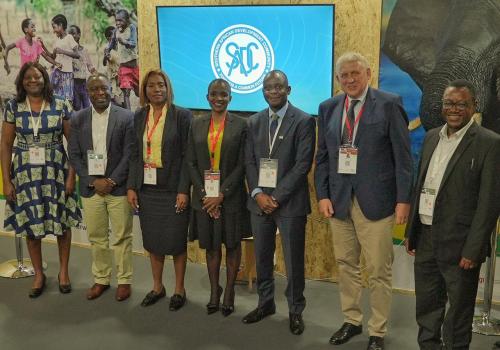The Southern African Development Community (SADC) will be participating in the IUCN African Protected Areas Congress (APAC) which taking place in Kigali, Rwanda from the 18-23 July 2022 at the Kigali Convention Centre. The APAC is the first ever continent-wide gathering of African leaders, citizens, and interest groups to discuss the role of protected areas in conserving nature, safeguarding Africa’s iconic wildlife, delivering vital life-supporting ecosystem services, promoting sustainable development while conserving Africa’s cultural heritage and traditions. The congress aims to position Africa’s protected areas within the broader goals of economic development and community well-being and to increase the understanding of the vital role parks play in conserving biodiversity and delivering the ecosystem services that underpin human welfare and livelihoods. The congress is an excellent platform for the regional economic community that comprises of 16 Members States to showcase its contributions the the conservation of biological diversity whilst uplifting social and economic development. The total SADC Protected Area (PA) estate comprises of 3940 PAs, covering approximately 1,900,000 km2 in terrestrial and 475,000 km2 in coastal and marine environments. Recognising that ecosystems across the globe are interrupted by political boundaries, SADC will share lessons learned in the establishment of Transfrontier Conservation Areas (TFCAs). TFCAs are the components of large ecological region that straddles the boundaries of two or more countries, encompassing one or more protected areas as well as multiple resource use areas.
SADC recognizes TFCAs as important areas for achieving regional cooperation and integration, including the strategic objective of sustainable utilisation and conservation of the region’s natural resources. SADC TFCAs are founded with the aim of collaboratively managing shared natural and cultural resources and represent an excellent example of successful integrated cross-border management of natural resources covering terrestrial, coastal and marine ecosystems. There are currently 18 TFCAs in the SADC region at different stages of development, covering over 1,000,000 km2 of shared ecosystems.
SADC’s work and experience in nature conservation and protection through the TFCA concept resonate with the main goals, objectives, and themes of APAC and the regional organization, supported by the German Development Cooperation through GIZ and KfW, the SADC TFCA Financing Facility, the International Union for Conservation of Nature (IUCN) and many other partners. SADC will be having its own pavilion where a number of high level events and activities will be taking place. SADC plans to leverage its presence at APAC to raise regional and global awareness of best practices in the management of transfrontier conservation areas, as well as seek solutions to related challenges and constraints. The challenges and constraints in managing TFCAs include the need for financing mechanisms such as the SADC TFCA Facility to become sustainable through linkages to other similar resource mobilization or funding mechanisms, as well as, for example, addressing policy bottlenecks that limit the ability of SADC to unlock the full potential of its wildlife economy.
The SADC Pavilion at APAC will be officially opened by Hon. Barbara Rwodzi Deputy Minister of Environment, Climate, Tourism and Hospitality Industry of Zimbabwe. The pavilion will host a series of high-level events, technical presentations and moderated panel discussions and associated visibility events, which, it is hoped, will catalyse further momentum and resources for transfrontier conservation in the region. These events will be led by highly qualified experts and will have a clear focus on key areas of high interest such as showcasing TFCA implementation as a strategy for regional integration, law enforcement programmes and initiatives to protect the natural resources of the region against illegal activities, socioeconomic growth and development of communities through nature-based tourism, and advancing wildlife conservation and sustainable utilization (trade) of wildlife products.
In addition to moderated panel discussions, the SADC Pavilion will also feature a series of high quality new videos showcasing four TFCAs and their significant positive impacts on nature conservation, wildlife protection and community development in the SADC region. These videos are a clear demonstration of SADC’s success in ensuring that nature conservation and protection through TFCAS benefit wildlife, biodiversity and people. Through the APAC, SADC hopes to share lessons and best practices on transfrontier conservation areas and catalyse technical and financial support for these entities. SADC also hopes to use APAC as a platform for garnering increased political commitment for cooperation and collaboration between the SADC region and other blocks across Africa on Protected Areas Conservation and sustainable utilization of wildlife products.

